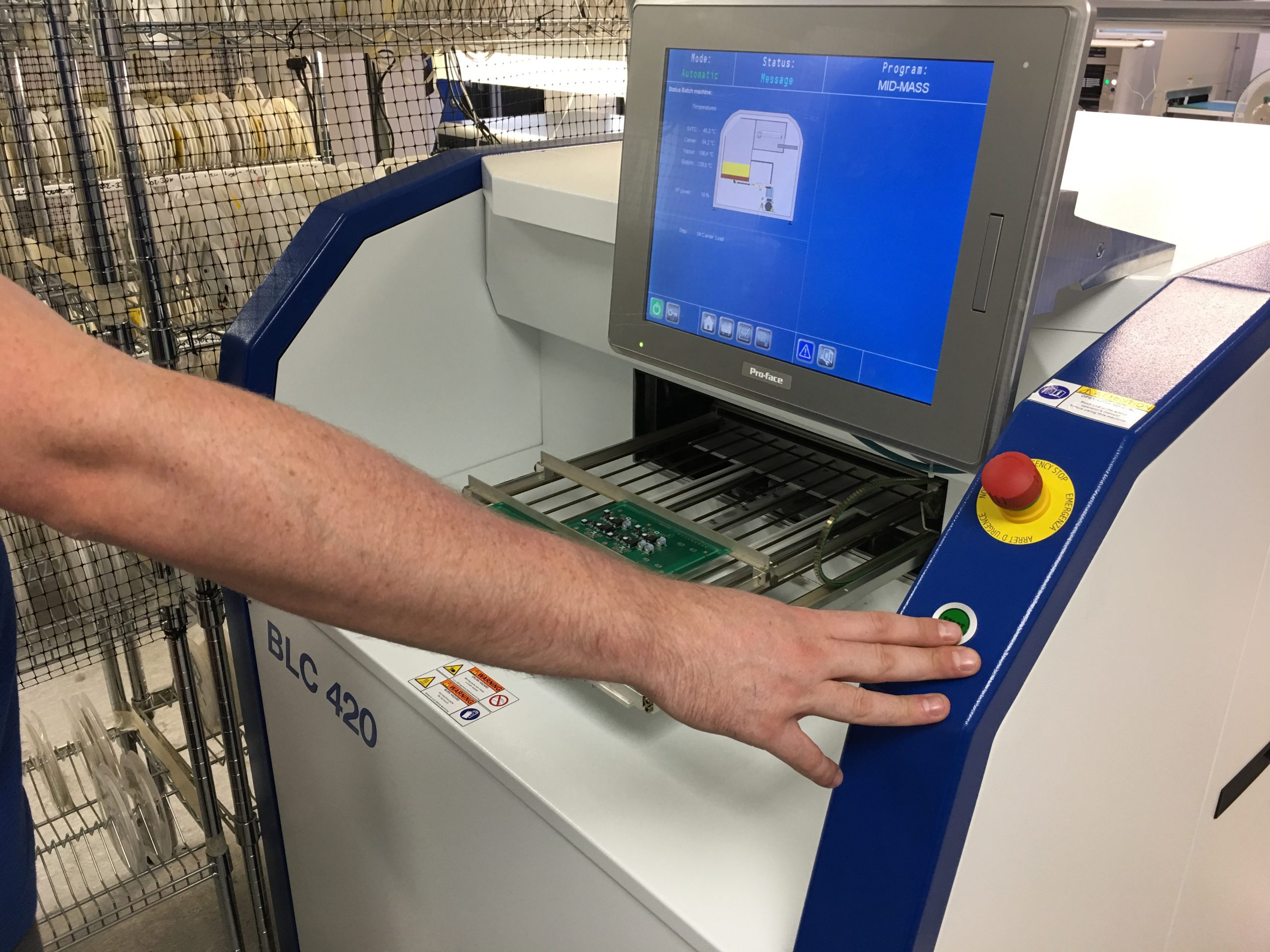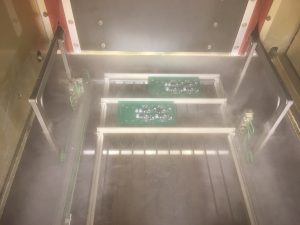
Why We’re Using A Vapour Phase Reflow Machine
Why Vapour Phase Reflow?
In our search for a Surface Mount Device (SMD) Reflow System that would not require constant profiling every time we ran a new job, Newbury Electronics was reintroduced to Vapour Phase Reflow machines. We wanted to improve the efficiency of our SMD process as the current set-up was causing delays and production bottlenecks, and Vapour Phase ovens have proven to be the best investment to eliminate these hold-ups.
Convection Reflow Profiles
Every PCB assembly may need a unique reflow profile and Convection Reflow as a method of SMT reflow soldering is not always suitable. Hot air convection reflow (HACR) profiles are influenced by the thermal mass of the PCB and its components, and the “colour” of the components. These change the rate at which heat is conducted from hot air in the oven. Profiling is where you monitor the temperature rise through an HACR oven with a thermocouple attached to the test PCB assembly. This takes time, and risks damaging the test board which may be precious if it is a small run.
Unlike Convection Reflow machines, which use hot air to apply heat to the PCB as it travels through a conveyor belt, Vapour Phase machines use the latent heat of condensation from a vapour layer, which is created by boiling a liquid at 235C. This process provides a high heat transfer and ensures very little temperature difference occurs between components of different thermal mass.
The History of Vapour Phase Reflow
VPR ovens have been around for a long time, but they once fell out of favour. Early machines lost a lot of the vapour phase fluid medium in the process, making them environmentally unfriendly and also unhealthy. They also had limited temperature profiles available. The reflow profile was limited to the vapour phase fluid medium used and the time in the tank. Handling through the process was usually manual and they could only process small batches of PCBAs (printed circuit board assemblies).

View Of The Vapour Chamber During Reflow
Modern VPR machines, however, are entirely enclosed and recover most of the vapour medium. Handling is automated and temperature profiles can be monitored and controlled precisely. As a result, Electronic Manufacturers are now taking advantage of this reflow soldering method for its simple and effective process. Here at Newbury Electronics, we selected and installed an IBL BLS 420 VPR machine because of its adaptability to all the types of PCBs we might see.
Soldering with VPR
Reflow soldering of SMD PCBAs may appear simple because all you need to do is apply some heat to melt the solder paste. But there is more to it than that. For a good solder joint, all the solder must be melted completely. In addition, it is essential that PCB pads and the component itself also reach a temperature above the melting point of the solder paste otherwise a cold solder joint will arise, i.e. a failed joint. This has to be done without overheating the components. In contrast to other soldering processes, with VPR, heat is transferred by condensing vapour and not by radiation, or forced convection gas or conduction from a soldering iron.
How Does This Soldering Method Work?
A Vapour Phase Reflow Machine works as follows. On switch on, the vapour phase fluid is liquid at room temperature at the bottom of the fluid tank. A heater boils the liquid at a typical lead-free solder paste melting point of 235C. This is not an accident, the fluid is specifically engineered to have this boiling point as it is the optimum temperature to melt solder paste. As the fluid boils, a thick blanket of vapour is created which is used to transfer the heat to PCBAs. The vapour is a higher density to air, and displaces all oxygen and provides an inert layer in the same way nitrogen would. Vapour condenses on the cold PCBA as it is introduced, heating up the circuit board until it is the same temperature as the vapour. The PCBA cannot overheat.
Vapour Phase Reflow ovens are smaller than Convection machines and fix the PCB in place. The physical height of the board is then adjusted so that it is fixed within the vapour layer. The rate of change of temperature is controlled by moving the PCBA higher or lower in the vapour and the profile of every PCBA reflowed is logged. It is a batch process with up to 8 or 12 circuits put through at one time, all of which are heated and cooled down at a controlled rate.
What Are the Advantages of Using A Vapour Phase Reflow Machine?
Vapour Phase Reflow is a great method for SMD PCBAs. The process window is far wider than that for HACR and there is no risk of overheating components. It is a reliable method for small runs of PCBAs where you need to get it right for the first time and offers 100% repeatability for low and high mass boards. As a result, it has become a favourite machine of ours at Newbury Electronics.
Request a quote for PCB Manufacture and PCB Assembly from Newbury Electronics today
Complete our online form or email sales@newburyelectronics.co.uk

